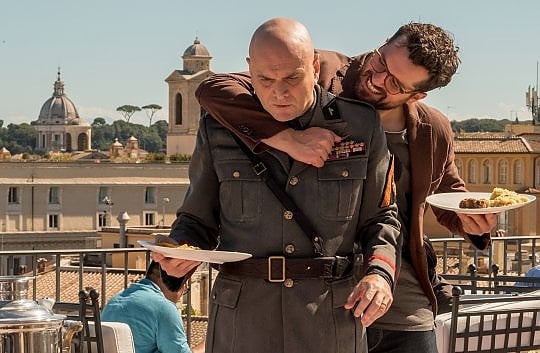
In Italian cinemas from February 1, I'm back It is the latest feature film directed by Luca Minieri, that takes its cue from the German feature He's back (direct in 2015 da David Wnendt), where we saw the figure of Adolf Hitler recur, straight from the past to the present day, in a German town.
we are in 2017. The young Andrea Canaletti is located in Piazza Vittorio, in Rome, in order to make a documentary on immigration. Suddenly it rains down from the sky a mysterious man, with feet tied by a rope, that so much is going to remember the Duce. And if it was really him? How would they react Italians nowadays? Canaletti, unaware that the man before him is really Mussolini, the latter decides to bring in around Italy, to achieve a sort of inquiry and see, from time to time, the reactions of the Italian population.
This feature Miniero - that, in fact, He reflects in every passage the previous German production - occurs primarily as an investigation and reflection on today's society, on the historical memory, just, on politics and how Italians after eighty years since the end of dictatorship and war they have changed. The final result, But, although with good initial intentions, It is less scratchy and less incisive feature Wnendt. Why, therefore, a job like this Miniero fails to hit the target and seems to remain in limbo, halfway between pure entertainment and films probing and provocative? The answer, apparently, It lies in the fact that one of the major flaws is the author himself was to have left too little room for real interviews, that he had walked the hand sufficiently, but merely, at least as far as the selected shot, the creation of a fiction that often seems to play with too many clichés, without necessarily having "dirty hands" and that, quasi, rentier thanks to the pre-existing German project, who knocked off a default narrative scheme. Except for, indeed, for the final scene - in which we see a Popolizio-Mussolini go around Rome on a convertible car in the middle forties style, where people on the screen are not actors or extras, but real passers, each of which has reacted in its own way after seeing the pseudo-leader around the city - everything else we see on screen is pure fiction, a simple task that plays very well the German model, but that, her and, mostly, again, It seems to put little.
Among the items most successful of the whole movie, First we find the interpretation of Massimo Popolizio in the role of Benito Mussolini - few other performers would know how to make it better - and, not least, the scene, emotionally strong, where an extraordinary Ariella Reggio - in the role of the protagonist's girlfriend grandmother - recognizes and Mussolini, remembering some episodes of his childhood, She throws him out of house shouting against.
Sin, therefore, Miniero that did not go all the way in his work. With these starting points and very good elements in it (think that even Frank Matano, in the role of Andrea Canaletti, It is not at all out of place), He could do very much more. If only the Italian cinema had more courage to dare, as it was done in the past decades!
marina fears
